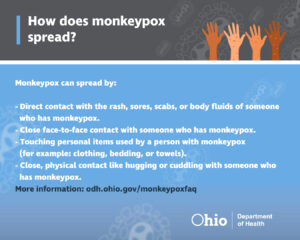Mpox
The Ohio Department of Health has launched a data dashboard that provides a statewide view of monkeypox transmission in Ohio. To view the dashboard, click here.
Interested in learning more about eligibility for the mpox vaccine in Clark County? Click here.
Information and FAQs

Public health officials at the Clark County Combined Health District continue to monitor the ongoing outbreak of mpox in the United States. CCCHD maintains regular contact with state and federal health officials to share updated information on the current local, regional, and national status of the outbreak.
Confirmed cases of mpox in:
United States – 30,123
Ohio – 392
Clark County – 3
 What is mpox?
What is mpox?
Mpox, formerly monkeypox, is a viral illness that typically begins with flu-like symptoms and swelling of the lymph nodes and progresses to a rash. Cases recently identified across the country appear less likely to have the initial symptoms of flu-like illness or lymph node swelling and the rash, which may look like pimples or blisters, may also stay contained to a particular part of the body.
How does mpox spread?
The virus can spread from person-to-person through direct contact with the infectious rash, scabs, or body fluids. It also can be spread by respiratory secretions during prolonged, face-to-face contact, or during intimate physical contact, such as kissing, cuddling, or sex. In addition, pregnant people can spread the virus to their fetus through the placenta.
Touching items (such as clothing or linens) that previously touched the infectious rash or body fluids is another way mpox spreads. It’s also possible for people to get mpox from infected animals, either by being scratched or bitten by the animal or by eating meat or using products from an infected animal.
How long does it last?
Mpox can be transmitted from the time symptoms start until the rash has fully healed and a fresh layer of skin has formed. The illness typically lasts 2-4 weeks. People who do not have symptoms cannot spread the virus to others. If you suspect you have been exposed contact your healthcare provider. The illness typically resolves itself and in some cases a medication may be available to treat those who have contracted monkeypox.
Who is most at risk of contracting mpox?
Right now, those at the highest risk for monkeypox include men who have sex with men, transgender or gender non-conforming people.
Click here to see more information about how those most vulnerable to contracting monkeypox can reduce their risk for catching the virus.
What should a person do if they have a new or unexplained rash or other symptoms?
Avoid sex or being intimate with anyone until you have been checked out by a healthcare provider. If you don’t have a provider or health insurance, call CCCHD at (937) 390-5600. Avoid gatherings, especially if they involve close, personal, skin-to-skin contact.
Think about the people you have had close, personal, or sexual contact during the last 21 days, including people you met through dating apps. To help stop the spread, you might be asked to share this information if you have received a mpox diagnosis.
How long is mpox contagious?
Mpox can spread from the time symptoms start until the rash is fully healed a fresh later of skin has formed. People who do not have mpox symptoms cannot spread the virus onto others.
What should I do if I’m notified a person I’ve had close contact with tested positive for mpox?
Contacts of animals or people confirmed to have monkeypox should be monitored for symptoms for 21 days after their last exposure. Contacts that remain asymptomatic can continue routine daily activities (e.g., go to work, school). Contacts should not donate blood, cells, tissue, breast milk, semen, or organs while they are under symptom surveillance.
